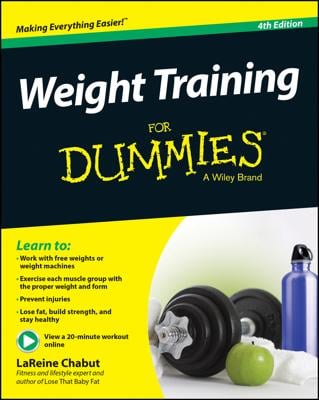How many reps should I do?
The number of reps you should do depends on where you are in your training (new, experienced, coming back from a long layoff) and your goals. To become as strong and as big as your body type will allow, do fewer than 8 or 10 reps per set. To tone your muscles and develop the type of strength you need for everyday life — moving furniture or shoveling snow — aim for 10 to 12 repetitions. Doing dozens of reps with ultralight weights (weights you can barely even feel) doesn’t bring good results of any kind, because you’re not stressing your muscles enough.No matter how many repetitions you do, always use a heavy enough weight so that the last rep is a struggle, but not such a struggle that you compromise good form. After about a month of strength training, you may want to go to muscular failure (that is, your last repetition is so difficult that you can’t squeeze out one more).
If you have a few different goals in mind, you can mix and match the number of reps you do per workout. If you want to get bigger and stronger and also improve the endurance of those muscles, you can do a heavy workout one day and a lighter workout the next time out. Keep track of how you feel; your body may respond better to one type of training than another.Be sure to adjust the amount of weight you use for each exercise. In general, use more weight to work larger muscles like your thighs, chest, and upper back, and use less weight to exercise your shoulders, arms, and abdominals. But even when doing different exercises for the same muscle group, you’re likely to need a variety of weights. For example, you typically can handle more weight on the flat chest-press machine than you can on the incline chest-press machine.
Write down how much weight you lift for each exercise so that next time around, you don’t have to waste time experimenting all over again. But don’t lock yourself into lifting a certain amount of weight every time. Everyone feels stronger on some days than on others.
 © Shutterstock/Catalin Petolea
© Shutterstock/Catalin PetoleaHow many sets should I do for each muscle group?
There’s no simple answer. Several studies show that doing one set per muscle builds just as much strength as doing three sets per muscle, at least for the first three or four months of training. If you’re a novice or if you’re starting again after a layoff, begin with one set of 10 to 12 repetitions, and make sure your last rep feels challenging. You should feel like you have control of the weight but if you did one more rep, you may not be able to make it all the way.Most people can increase their initial weights after two to four weeks of training; at that point, consider adding a second or even third set for each muscle group. However, if your goal is simply to build enough strength for good health, one challenging set may be sufficient.
If you’re aiming for maximum strength or a physique like the ones you see on ESPN body-building competitions, you need to do at least 10 to 20 sets per muscle group!

